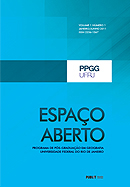Multicriteria Assessment for the Viability of Onshore Wind Farms in the Coastal Zone of Sergipe – Brazil
DOI:
https://doi.org/10.36403/espacoaberto.2024.62743Keywords:
Geoecological functions, Coastal of Sergipe, SWOT, Geomorphological CartographyAbstract
Energy production through wind stands out as one of the main alternatives for combating global warming. The present study aims to evaluate the feasibility of implementing onshore wind farms in the coastal landscape of the state of Sergipe through geoecological analysis, classifying natural and anthropogenic aspects into strengths, weaknesses, opportunities, and threats, using the SWOT matrix. Preparing a geomorphological mapping of the 5 km section of the current coastline, it was verified that the geomorphological domain of the Coastal Plain is composed of geologically recent and unstable morphologies. This characteristic is one of the main weaknesses of the landscape for the implementation of onshore wind farms on the coast of Sergipe. On the other hand, the Coastal Tablelands located within the adopted spatial outline are the most suitable geomorphological domain for the implementation of wind farms, as they are geologically older and more stable.
Metrics
Downloads
Published
How to Cite
Issue
Section
License
Copyright (c) 2024 Paulo Henrique Neves Santos, Rosemeri Melo e Souza, Manoel do Couto Fernandes, Neise Mare de Souza Alves

This work is licensed under a Creative Commons Attribution-NonCommercial-ShareAlike 4.0 International License.


